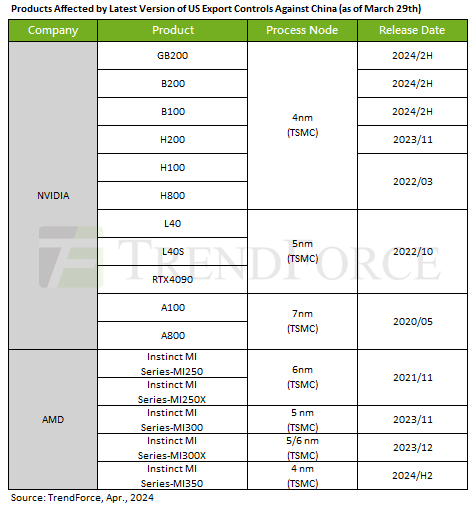U.S. Updates Advanced Semiconductor Ban, Actual Impact on the Industry Will Be Insignificant, Says TrendForce – Press Center | TrendForce – Market research, price trend of DRAM, NAND Flash, LEDs, TFT-LCD and green energy, PV
On March 29th, the United States announced another round of updates to its export controls, targeting advanced computing, supercomputers, semiconductor end-uses, and semiconductor manufacturing products. These new regulations, which took effect on April 4th, are designed to prevent certain countries and businesses from circumventing U.S. restrictions to access sensitive chip technologies and equipment. Despite these tighter controls, TrendForce believes the practical impact on the industry will be minimal.
The latest updates aim to refine the language and parameters of previous regulations, tightening the criteria for exports to Macau and D:5 countries (China, North Korea, Russia, Iran, etc.). They require a detailed examination of all technology products' Total Processing Performance (TPP) and Performance Density (PD). If a product exceeds certain computing power thresholds, it must undergo a case-by-case review. Nevertheless, a new provision, Advanced Computing Authorized (ACA), allows for specific exports and re-exports among selected countries, including the transshipment of particular products between Macau and D:5 countries.
Furthermore, TrendForce notes that the extension of export controls now includes not only the previously restricted AI chips from NVIDIA and AMD, such as the NVIDIA A100/H100, AMD MI250/300 series, NVIDIA A800, H800, L40, L40S, and RTX4090, but also their next-generation successors like NVIDIA's H200, B100, B200, GB200, and AMD's MI350 series. In response, HPC manufacturers have quickly developed products that comply with the new TPP and PD standards, such as NVIDIA's adjusted H20/L20/L2, which remain eligible for export.
Despite the updated regulations emphasizing stricter reviews for products exceeding computing power limits, the actual additional impact on the industry from these updates is expected to be insignificant. Consumer GPUs like NVIDIA’s RTX 4090, which were previously restricted due to their computing power, highlight that the updates aim more at closing existing regulatory loopholes rather than creating new significant barriers. In the long run, while the U.S. intends to block China's access to and development of advanced technologies, these measures may inadvertently speed up China's progress in developing AI chips and advanced manufacturing processes. In seeking technological superiority, the U.S.'s latest efforts might paradoxically fuel the advancements it seeks to hinder.
For more information on reports and market data from TrendForce’s Department of Semiconductor Research, please click here, or email the Sales Department at [email protected]
For additional insights from TrendForce analysts on the latest tech industry news, trends, and forecasts, please visit https://www.trendforce.com/news/
Subject
Related Articles
Related Reports
